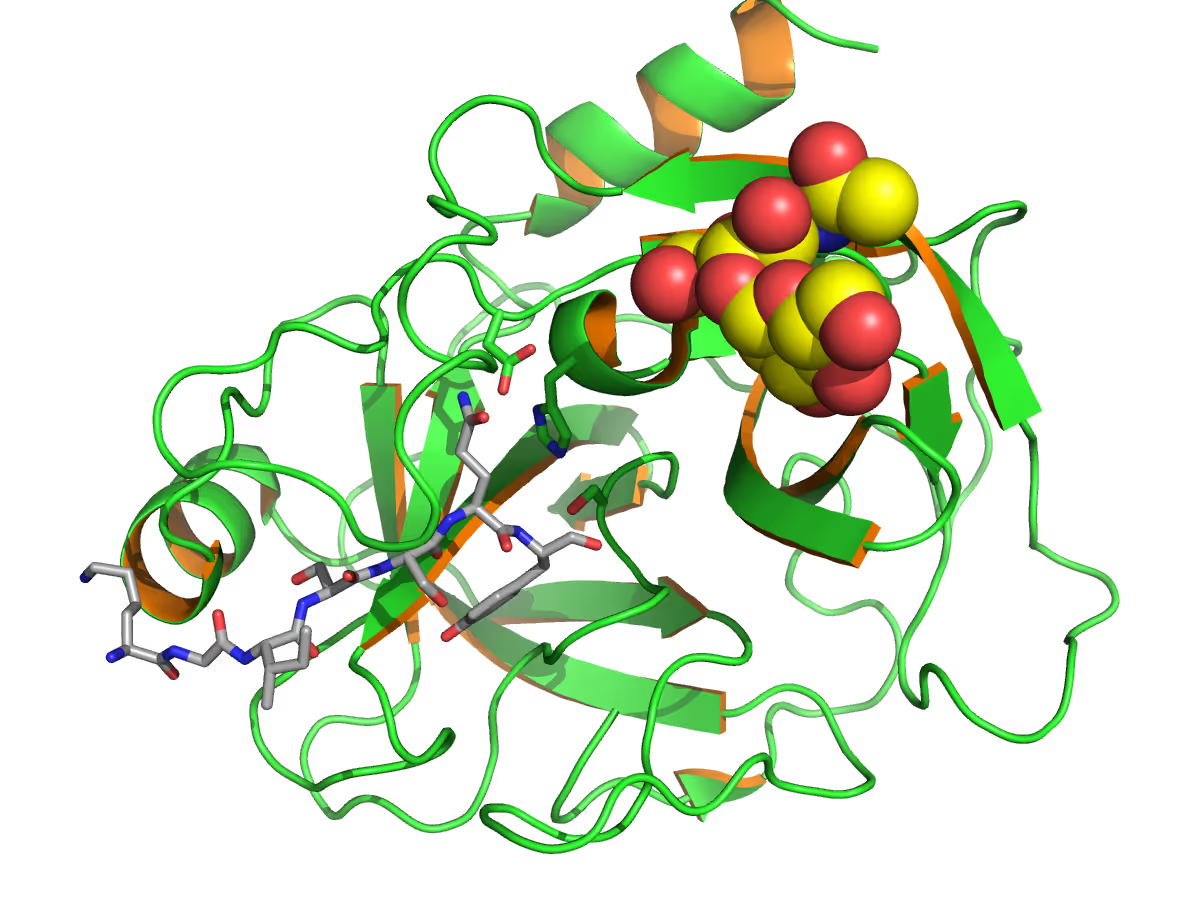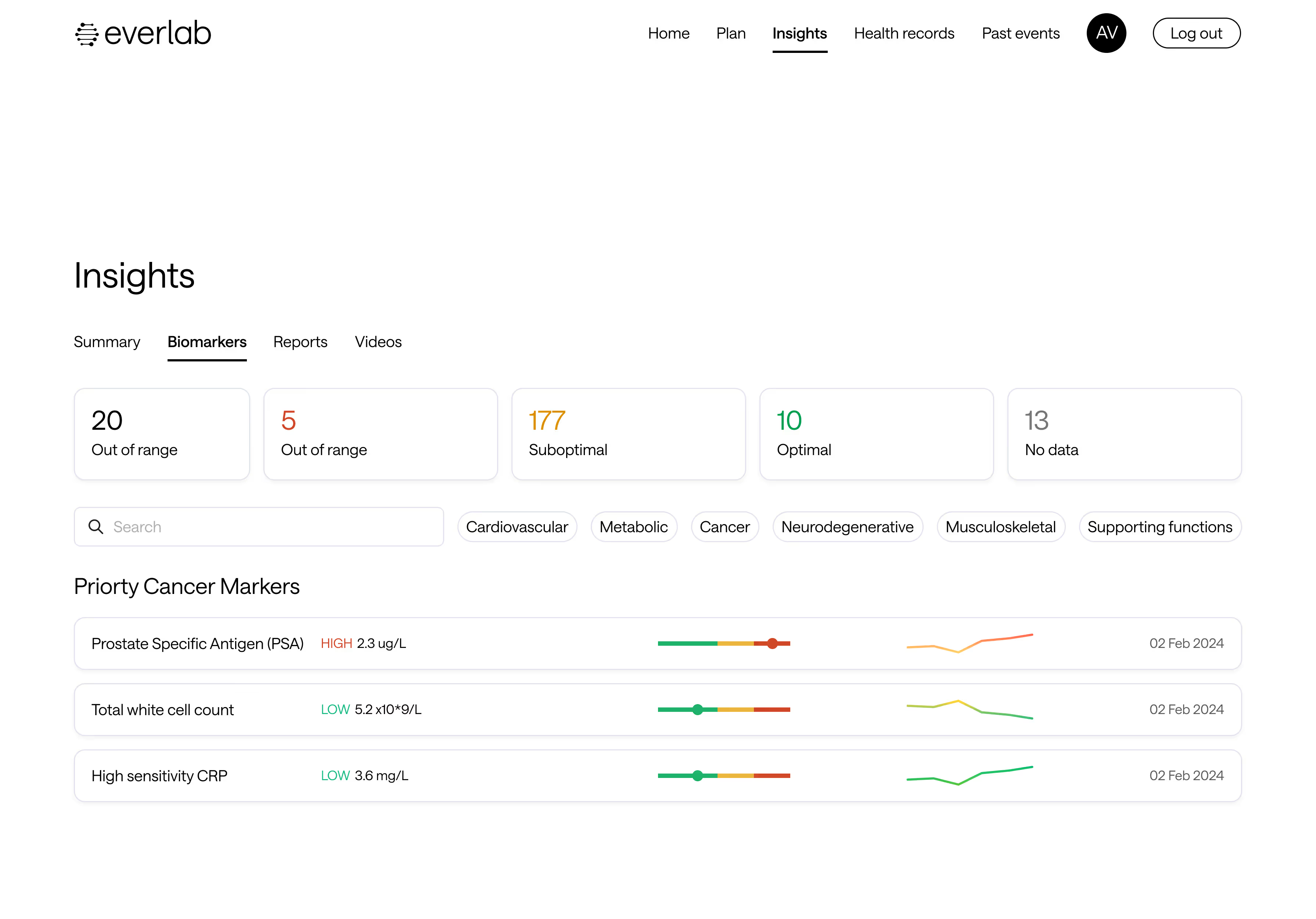Prostate Specific Antigen (PSA)
Prostate-specific antigen (PSA) is an essential marker for men’s health, especially when it comes to understanding and managing prostate health. A PSA test can provide early detection of potential issues, including prostate cancer. This guide will explore what PSA is, how the PSA test works, how to prepare for it, and how to interpret your results. We’ll also discuss the risks and limitations of the test, its relationship to long-term health, and steps you can take to improve your results.

Prostate Specific Antigen (PSA) | Marker for Prostate Health
What:
Blood Biomarker
Tests for:
Prostate Health
Referral:
Required
Member cost:
$30-$70
What Is PSA?

PSA is a protein produced by the prostate gland, located below the bladder in men. It plays a key role in male reproductive health by helping semen remain fluid.
The prostate gland also produces other substances critical for reproductive health, such as enzymes and minerals. Although PSA is a widely used marker for prostate health, its production and regulation are part of a complex interplay of hormonal signals.
It's important to note that PSA levels can naturally increase with age. Additionally, some men with prostate cancer may still have a normal PSA level, highlighting the complexities of interpreting PSA test results.
It’s crucial to understand that while PSA is a helpful marker, it is not cancer-specific. For this reason, healthcare providers use PSA results alongside other tests and patient history for a more accurate diagnosis.
Types of PSA Tests
- Total PSA Test: Measures the overall amount of PSA in the blood.
- Free-to-Total PSA Ratio Test: Measures the percentage of PSA that is free compared to the total PSA in the blood, aiding in distinguishing between prostate cancer and non-cancerous conditions like benign prostatic hyperplasia (BPH).
Emerging innovations include PSA-based genetic testing, which examines a person’s genetic predisposition to aggressive prostate cancers. These tests are becoming increasingly accessible and could complement traditional PSA testing.
How Is PSA Measured?
A PSA test involves drawing a small blood sample, typically from your arm. The sample is then analysed in a lab to measure PSA levels, expressed in nanograms per millilitre (ng/mL).
Lab procedures for PSA testing are becoming more sophisticated, with some clinics offering high-sensitivity PSA tests that can detect even minute changes in PSA levels. This is particularly useful for monitoring men with a history of prostate cancer.
How to Prepare for a PSA Test
To ensure accurate results, follow these preparation tips:
- Avoid Ejaculation: Refrain from sexual activity for 48 hours before the test, as it can temporarily raise PSA levels.
- Skip Strenuous Exercise: Avoid activities like cycling or heavy lifting for 48 hours, as they may irritate the prostate.
- Disclose Medications: Let your doctor know about any medications or supplements, especially testosterone or finasteride, as they can influence PSA levels.
- Schedule Timing: Ideally, avoid testing if you have a urinary tract infection or recent prostate procedures, as these can skew results.
In addition, consuming a diet low in processed foods and alcohol in the days leading up to the test may help minimise factors that could irritate the prostate. Always consult your healthcare provider for personalised advice before the test.
How to Interpret PSA Test Results

PSA levels are measured in ng/mL, and what is considered “normal” varies based on age and individual factors.
When interpreting PSA results, healthcare providers also consider factors such as prostate size, patient ethnicity, and family history of prostate cancer. For instance, some ethnic groups have slightly higher or lower baseline PSA levels, which could influence the interpretation of results.
General PSA Ranges
However, normal ranges can depend on your age:
- 40–49 years: Less than 0.8 ng/mL
- 50–59 years: Less than 0.95 ng/mL
- 60–69 years: Less than 1.2 ng/mL
- 70+ years: Less than 1.5 ng/mL
In certain cases, PSA levels may warrant additional testing, such as imaging scans or advanced biomarker analysis, to rule out false positives.
What High PSA Levels Might Indicate
- Prostate cancer: Elevated PSA can indicate cancerous changes in the prostate gland, though not all increases are due to malignancy.
- Benign prostatic hyperplasia (BPH): Enlargement of the prostate is common with age and can cause PSA levels to rise.
- Prostatitis: Inflammation or infection of the prostate can lead to temporary spikes in PSA.
Additional testing, such as imaging and biopsy procedures, is necessary to accurately diagnose prostate cancer following elevated PSA levels. Persistent high PSA levels often prompt healthcare providers to perform repeat tests over several months to confirm trends. This approach reduces unnecessary biopsies caused by transient PSA spikes.
What Low PSA Levels Might Indicate
Low levels are generally not a concern but are common after certain medications or treatments. However, very low PSA levels in men undergoing treatment for prostate cancer can indicate that the therapy is effectively managing the condition. This makes PSA monitoring an invaluable tool during and after cancer treatment.
What Happens if a Screening Test Shows an Elevated PSA Level?

Discovering an elevated PSA level during a screening test can be concerning, but it doesn’t necessarily mean you have prostate cancer. It does, however, indicate the need for further evaluation to determine the cause. Here’s what typically happens next:
- Repeat PSA Test: Your doctor may suggest repeating the PSA test to confirm the initial result. PSA levels can fluctuate, and a single elevated reading might not be accurate.
- Digital Rectal Exam (DRE): A DRE allows your doctor to feel the prostate gland for any abnormalities. This physical exam can provide additional clues about your prostate health.
- Imaging Tests: Depending on the situation, your doctor might recommend imaging tests such as an ultrasound, MRI, or CT scan. These tests help visualize the prostate gland and surrounding tissues.
- Prostate Biopsy: If PSA levels remain elevated and other tests suggest the possibility of prostate cancer, a prostate biopsy may be necessary. This involves removing a small sample of prostate tissue to check for cancer cells.
- Prostate Health Index (PHI): The PHI test is a blood test that measures PSA and other proteins to assess the risk of prostate cancer more accurately.
- PSA Velocity: Your doctor might calculate your PSA velocity, which is the rate of change in PSA levels over time. A rapid increase can indicate a higher risk of prostate cancer.
- Free PSA: Measuring the level of free PSA (PSA not bound to proteins) in your blood can provide additional information. Lower levels of free PSA may be associated with a higher risk of prostate cancer.
It’s important to remember that elevated PSA levels can be caused by various factors, including benign prostatic hyperplasia (BPH), prostatitis, and prostate infections. Discussing your results with your doctor will help determine the best course of action.
Emerging imaging techniques like mpMRI (multi-parametric MRI) provide highly detailed visuals of the prostate and can sometimes eliminate the need for an immediate biopsy.
Risks and Limitations of PSA Testing
While PSA testing is a valuable tool, it has its limitations:
1. False Positives
Elevated PSA levels don’t always mean cancer. Benign conditions like BPH or infections can also cause a spike.
2. False Negatives
Some men with prostate cancers may still have normal PSA levels, which underscores the need for additional diagnostic tools.
False negatives can delay treatment, which is why complementary testing methods like advanced imaging or molecular markers are gaining traction in clinical practice.
3. Overdiagnosis
PSA testing can detect slow-growing cancers that may never cause harm, leading to unnecessary treatments.
Overdiagnosis can lead to unnecessary prostate cancer treatment, which may have significant side effects and impact quality of life.
How PSA Levels Relate to Long-Term Health
Early Detection Saves Lives
High PSA levels can signal prostate cancer before symptoms appear, improving outcomes with early intervention.
For men with a family history of prostate cancer, early and regular PSA testing is especially critical in reducing mortality rates.
Monitoring Overall Health
Regular PSA testing can track changes over time, helping identify trends that require attention, even for benign conditions like BPH.
Chronic conditions such as diabetes and cardiovascular disease can also influence PSA levels indirectly, making routine health monitoring essential for older men.
At Everlab, we include PSA testing as part of a comprehensive preventative health program to provide a full picture of your health.
How to Improve PSA Test Results
Taking steps to improve your prostate health can naturally lead to healthier PSA levels.
1. Diet and Nutrition
- Eat a prostate-friendly diet: Include foods rich in antioxidants, like tomatoes (lycopene), green tea, and fatty fish (omega-3s).
- Limit red and processed meat: High consumption is linked to prostate issues.
Some studies suggest that cruciferous vegetables like broccoli and cauliflower may help reduce the risk of prostate cancer by inhibiting abnormal cell growth.
2. Maintain a Healthy Weight
Obesity has been associated with higher PSA levels and an increased risk of prostate cancer. Regular exercise and a balanced diet can help maintain optimal weight.
Maintaining a healthy weight can help reduce the risk of prostate symptoms, which may indicate underlying prostate issues.
3. Exercise Regularly
Moderate physical activity supports prostate health. Regular exercise and a healthy lifestyle can help reduce the need for unnecessary prostate biopsies by maintaining overall prostate health. However, avoid activities like cycling close to testing as it may temporarily elevate PSA.
4. Reduce Stress
Chronic stress can contribute to hormonal imbalances that affect PSA levels. Incorporate relaxation techniques like mindfulness or yoga into your routine.
5. Quit Smoking and Limit Alcohol
Both smoking and heavy alcohol consumption are linked to poorer prostate health. Reducing or eliminating these habits can positively impact PSA levels.
Take Control Of Your PSA
PSA is a vital marker for monitoring prostate health and assessing the risk of prostate-related conditions. Elevated PSA levels can signal potential issues such as prostate cancer, benign prostatic hyperplasia (BPH), or prostatitis. By understanding your PSA levels, healthcare providers can develop tailored strategies for early detection, risk reduction, and ongoing care. At Everlab, our PSA testing doesn’t just provide data—it offers actionable insights. With regular monitoring and personalised recommendations, you’ll have the tools to take charge of your prostate health, enhance your wellbeing, and safeguard your long-term healthspan.



imaging

biomarkers

sterols
Book a Free Discovery Call
Join 20,000+ Australians improving their health with proactive, personalised healthcare.